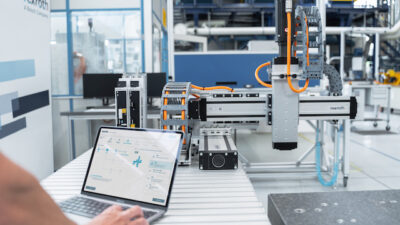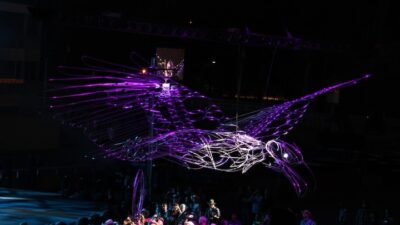A number of trends are pushing motor drives to operate more intelligently. The first is that more intelligent algorithms can drive motors more efficiently at a given torque and speed. The second is that system efficiency increases when the motor is driven at the exact power level needed, rather than throttling.
LINKS
For more on intelligent motor control, see www.controleng.com/machine
Sidebars: Intelligent motor control ICs
A number of trends are pushing motor drives to operate more intelligently. The first is that more intelligent algorithms can drive motors more efficiently at a given torque and speed. The second is that system efficiency increases when the motor is driven at the exact power level needed, rather than throttling. Finally, motor drives are increasingly connected via networks which require processing of an intelligent command protocol.
A category of integrated circuit (IC) called an Intelligent Motor Controller (IMC) has evolved that addresses these needs by simplifying the task of designing high-performance motor control drives.
Intelligent Motor Controller ICs are a relatively new class of IC that can save significant engineering expenses when building high-performance motor drives for multi-phase motors such as brushless dc motors, or three-phase ac induction motors.
IMCs are programmable single-IC controllers that provide high level functions such as digital torque control, sinusoidal commutation, field oriented control, Hall sensor input, braking, regeneration, and over-temperature management. At the same time they directly input torque and velocity commands, and output six high side/low side signals with shoot-through protection for use with an external MOSFET (metal-oxide semiconductor field-effect transistor) or IGBT (insulated-gate bipolar transistor) switcher.
Industries well served by these devices include HVAC (heating, ventilation and air conditioning), centrifuges, medical equipment, electric vehicles, pumps, and other applications that drive motors in the 500W or higher range and require high operating efficiency and intelligent performance.
IMCs generally provide more sophisticated approaches for controlling motors, and also typically provide some sort of serial network connectivity such as SPI or CANbus.
The “Intelligent motion control integrated circuit schematic” graphic shows the internal block diagram of a typical intelligent motor controller IC. It provides microprocessor-style command input, and can accept torque or velocity commands through a direct analog voltage, or SPI (Serial Peripheral Interface). IMCs control multiphase motors, particularly brushless dcmotors and multi-phase ac induction motors. IMCs primarily serve higher power, larger motor markets with drives of 1kW all the way up to 500kW or higher.
The software provided with the IMC makes setting up the developer’s kit with your motor easy, and provide features such as auto tuning. Additional features that will come in handy include a trace feature for optimizing performance, and communications via serial, CANBus, or Ethernet to the PC.
Dedicated motor controller ICs have been around for a long time. In particular, low-cost ICs that control specific applications such as low power step motors or brushless motors for disk drives or tape drives have been available for years.
What is different about IMCs is that they serve general motor control markets, where the motor size or load characteristics are not known in advance. Also, they generally provide significantly more sophisticated approaches for controlling motors. IMCs also typically provide some sort of serial network connectivity such as SPI or CANbus, while older dedicated motor control ICs do not.
In the future, it is possible that we will see the role of IMCs expand to include other motor types, such as variable reluctance or switched reluctance motors. Currently, most intelligent motor controller ICs are designed to interface with external gate pre-drivers. As IMCs become more popular and gain in sophistication, these capabilities will likely be integrated, negating the need for an interface. Integrating the MOSFET or IGBT bridges directly onto the IMC may be possible one day, but doing so would limit the IMC to a specific application.
Where such applications exist in high quantity, such as with white goods or electric/hybrid vehicles, this integration would be welcome. For most industrial machine manufacturers, however, the flexibility of matching a general purpose IMC to an application-specific switching bridge is a better approach.
The specific energy efficiency offered by IMCs involves the motor being driven more efficiently at a given motor speed and torque. From very simple approaches like six-step commutation, to more complex techniques like field oriented control (also called flux vector control), improvements are in the range of 2% to 10% depending on the motor and application. For most applications, significantly larger efficiency gains of 20% or more are possible when running the motor at a variable speed, or bi-directionally.
The classic example of how variable speed can deliver system efficiencies is a fan that must deliver a variable volume of air per minute. When run at full speed, an advanced drive may gain a few percentage points compared to an older drive. But when operated at less than full air flow, the older ‘full-on only’ drive must operate in combination with a damper to throttle air flow, or vary between ‘full on’ and ‘full off’ with a duty cycle to deliver a certain average volume of air. In either case, the system efficiency is much worse than a drive that can throttle its output, because at full speed, efficiency-robbing turbulent airflow and resistive backpressure are at their highest.
An example of how bi-directional control can improve system efficiency is a washing machine that spins at a very high speed during the spin cycle. In this application, bi-directional speed allows the washing machine to better distribute the load, allowing higher spin speeds. This, in turn, results in dryer clothes and less energy needed by the dryer.
Author Information
Chuck Lewin is founder and vice president of engineering at Performance Motion Devices Inc.
Intelligent motor control ICs
Intelligent motor controller ICs are available from several different vendors. One example of such a product is the MC73110 from Performance Motion Devices. This compact 64-pin IC provided in a high density surface mount package, provides commutation, field-oriented control, and MOSFET or IGBT excitation for a three-phase brushless dc motor. It can be purchased with a developer’s kit and reference schematic for building a customized, high-performance motor drive.



